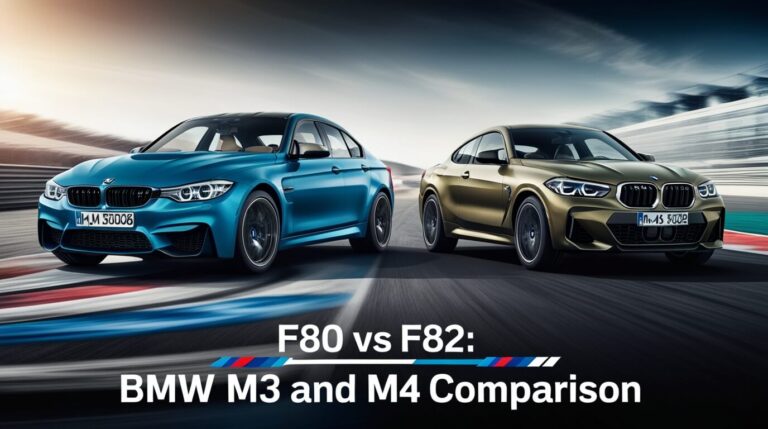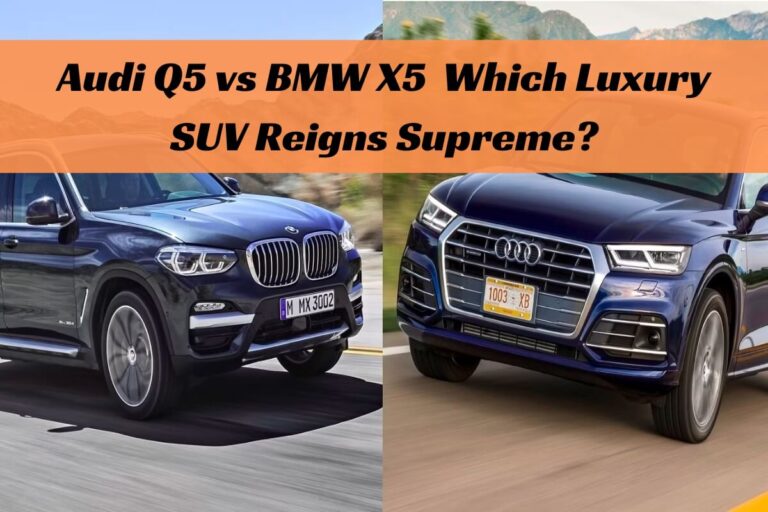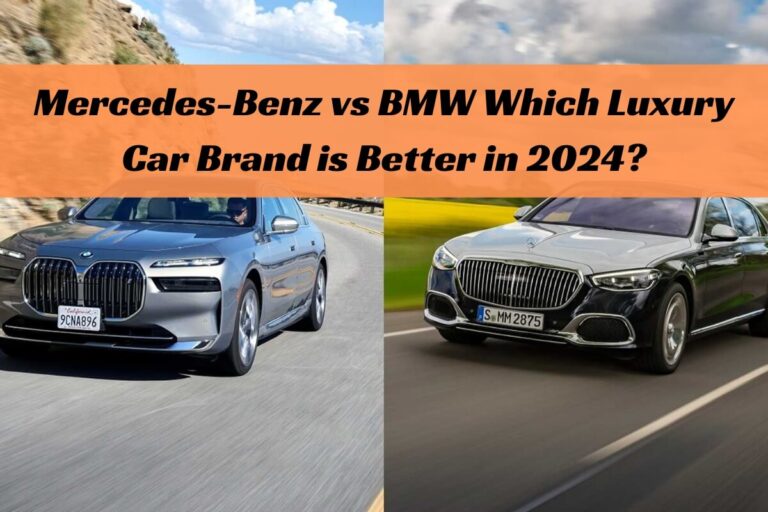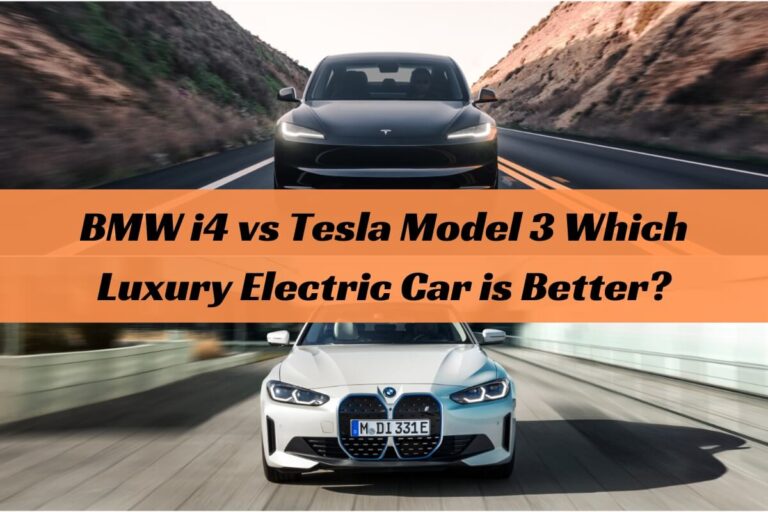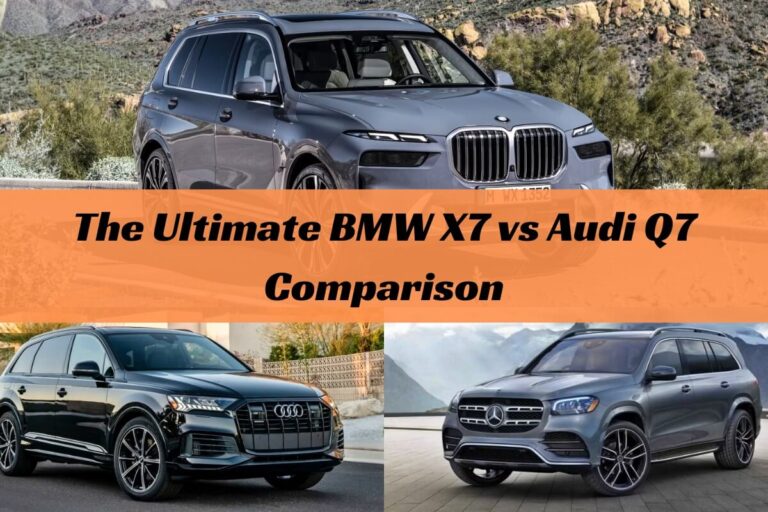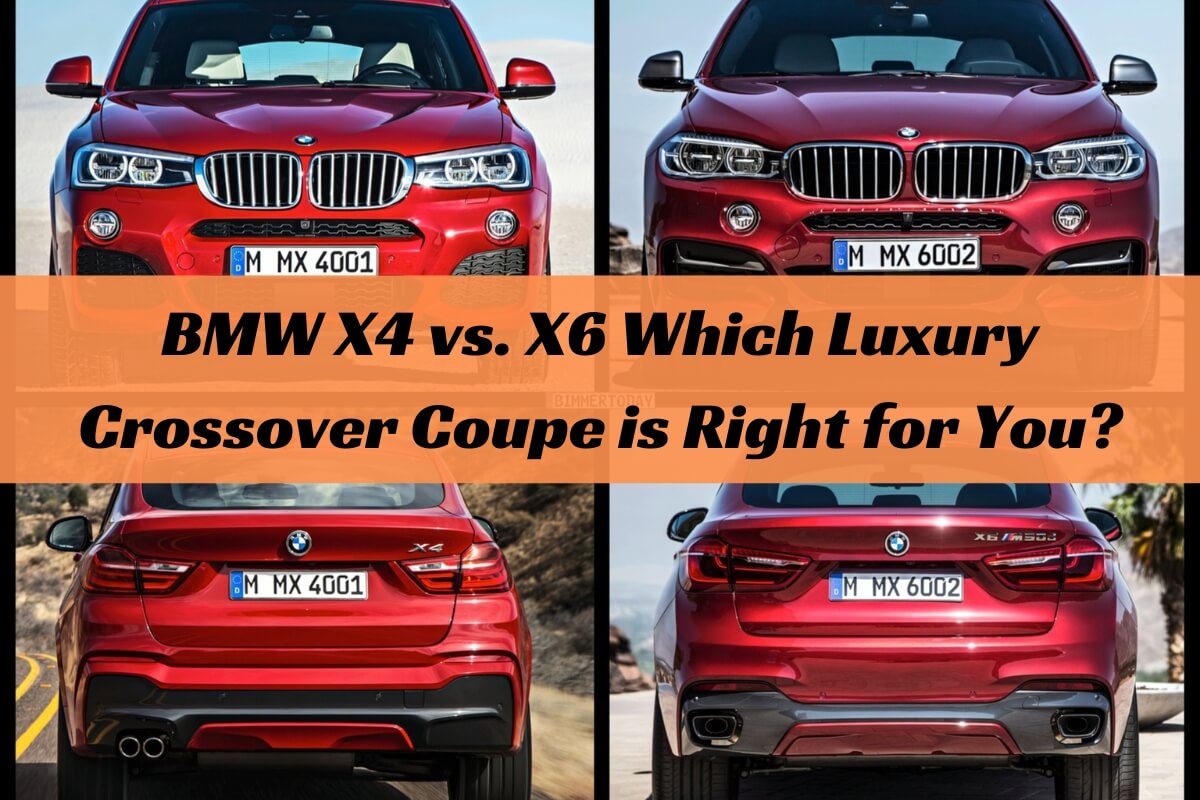
The BMW X4 and X6 are part of a relatively new breed of luxury vehicles that blend the sleek, coupe-like styling of a sports car with the rugged capabilities and versatility of an SUV. Known as “crossover coupes” or “sports activity coupes,” these models offer a unique combination of head-turning design and everyday practicality.
But which one is the better choice for you – the BMW X4 or the X6?
The BMW X4 is the more affordable and agile option, making it well-suited for city dwellers and driving enthusiasts. The larger X6 sacrifices some maneuverability for more interior space, off-road prowess, and a commanding road presence.
To help you decide between these two distinctively-styled luxury crossovers, this in-depth guide will cover:
- The key differences in exterior design, dimensions, and road presence
- How interior space, cargo room, and cabin comfort compare
- Performance capabilities across the standard and high-powered M variants
- Fuel efficiency ratings and expectations
- Pricing, trim levels, and overall value proposition
- Factors like projected resale value down the line
So if you’re torn between the BMW X4 and X6 for your next luxury vehicle purchase, read on for a detailed breakdown of how these crossover coupe cousins stack up across all the most important considerations.
What is the BMW X4?
The BMW X4 is the German automaker’s smaller crossover coupe offering. It’s based on the X3 compact luxury SUV but with a fastback-style sloping roofline that gives it a sportier, coupe-inspired profile.
For the 2023 model year, the X4 comes standard with a 2.0-liter turbocharged four-cylinder engine producing 248 horsepower. Step up to the M40i trim and you get a potent 3.0-liter turbocharged inline-six making 382 hp. Both engines come paired with an eight-speed automatic transmission and BMW’s xDrive all-wheel-drive system.
Thanks to its compact footprint and performance-oriented tuning, the X4 delivers agile handling and precise steering. It prioritizes a fun, driver-focused experience compared to traditional SUVs. However, that coupe-like design does come with some practicality tradeoffs in areas like cargo space and rear headroom.
What is the BMW X6?
The BMW X6 is the big brother to the X4, providing a larger interpretation of the crossover coupe concept. It’s based on the X5 midsize luxury SUV and shares that model’s robust driving dynamics and off-road capabilities.
Like the X4, the 2023 BMW X6 offers multiple turbocharged engine choices. The base xDrive40i model comes with a 3.0-liter turbo inline-six producing 375 hp, while the X6 M model gets a thundering 4.4-liter twin-turbo V8 with a staggering 617 hp on tap. All X6 variants use an eight-speed automatic and BMW’s xDrive AWD system.
With its larger dimensions and more substantial road presence, the X6 delivers a different driving experience than the X4. It has a more planted, confident feel on the road but isn’t quite as nimble or sporty as its smaller sibling. The coupe-like styling also takes a bigger bite out of cargo space compared to traditional midsize luxury SUVs.
Design and Exterior Styling
One of the most significant differences between the BMW X4 and X6 is their overall size and exterior presence. The X4 has a length of 187.6 inches, width of 75.5 inches, and height of 63.8 inches, while the X6 comes in at 194.8 inches long, 78.9 inches wide, and 66.9 inches tall.
This substantial increase in dimensions gives the X6 a more muscular, imposing stance on the road. Its larger proportions, along with design cues like the prominent kidney grilles and squared-off rear sections, lend it an undeniable road presence that the sleeker X4 can’t quite match.
However, both models share a defining feature in their sloping, fastback-style rooflines that taper down toward the rear. This coupe-inspired silhouette is what gives the X4 and X6 their sporty, distinctive looks compared to more traditionally-shaped SUVs.
Do the BMW X4 and X6 Look Different in Person?
While photos can certainly showcase the crossover coupe designs, many owners report that the styling of the BMW X4 and X6 looks even more dramatic and head-turning in person. The sculpted bodylines and low-slung profiles really pop when you see them up close.
Some finer exterior details that stand out include the intricate LED lighting designs, aggressive front air intakes, and perfectly-raked rear window angles. These details help reinforce the luxurious yet sporty aesthetic BMW was aiming for with these models.
Interior Space and Comfort
The main sacrifice that comes with the BMW X4 and X6’s sleek coupe-inspired styling is interior room and cargo space. Their sloping rooflines cut into rear headroom, while the tapered rear sections limit cargo versatility compared to boxier SUV shapes.
The smaller footprint of the X4 means it has less interior volume overall. Rear seat passengers only get 35.5 inches of legroom and 37.5 inches of headroom. Cargo capacity is 18.5 cubic feet behind the rear seats or 50.5 cubes with them folded down.
Move up to the larger X6 and those interior measurements improve somewhat. Rear legroom is 35.7 inches, while rear headroom is a bit more generous at 37.8 inches. You also get 27.4 cubic feet of cargo volume that expands to 59.6 cubes with the rear seats folded flat.
While neither vehicle offers class-leading interior space, the X6’s larger footprint does provide some welcome extra room for passengers and cargo over the X4. Both models offset their packaging constraints with premium materials and attention to detail.
The cabins use upscale leather upholstery, genuine wood and aluminum trim, and soft-touch surfaces on the upper dashboards and door panels. Options like quilted leather seating, heated armrests, and glass controls further elevate the luxury experience.
BMW’s latest iDrive infotainment system features crisp displays and user-friendly controls. Standard active noise cancellation also provides a serene, well-insulated cabin environment in both models. So while space may be at a premium, you won’t want for premium amenities or build quality.
Which Has the Better Infotainment and Tech Features?
When it comes to infotainment systems and advanced technology features, the BMW X4 and X6 are largely on equal footing. Both utilize the brand’s latest Live Cockpit Professional system, featuring:
- A 12.3-inch digital instrument cluster
- A 12.3-inch center touchscreen
- Navigation with real-time traffic data
- Wireless Apple CarPlay and Android Auto
- Voice command functionality
- Available gesture controls
The iDrive interface is clean, responsive, and reasonably intuitive to use. Handy features like wireless device charging and a wi-fi hotspot help keep you connected.
On the driver-assistance technology front, both the X4 and X6 provide the full gamut of active safety features like:
- Forward collision warning with automatic emergency braking
- Lane departure warning
- Blind spot monitoring
- Rear cross-traffic alert
- Available adaptive cruise control with stop & go
- Available front/rear parking sensors and surround-view cameras
Higher trim levels also make advanced tech like BMW’s augmented-view navigation system and hands-free highway driving assistant available. But in general, neither the X4 nor X6 holds a significant advantage over the other when it comes to in-car tech.
Performance and Driving Experience
While the BMW X4 and X6 prioritize style and luxury, they haven’t forgotten their Ultimate Driving Machine heritage when it comes to performance and handling dynamics. Multiple turbocharged engine options provide an energizing driving experience, especially in the higher-performance variants.
The X4’s standard 2.0-liter turbo-four pumps out 248 hp, enough for a 0-60 mph time in the low 6-second range. The real star is the M40i model’s 382 hp 3.0-liter turbo inline-six, capable of a blistering 0-60 mph in just 4.4 seconds.
The X6 lineup follows a similar formula but with more powerful engines to motivate its larger mass. The base xDrive40i comes with a 3.0-liter turbocharged inline-six making 375 hp and 368 lb-ft of torque. That’s enough muscle to hustle the X6 from 0-60 mph in a brisk 5.3 seconds.
For pure performance, the X6 M models crank things up with a 4.4-liter twin-turbo V8 belting out 600 hp and 553 lb-ft. The M60i hits 60 mph in a scant 3.8 seconds, while the hardcore X6 M Competition cuts that down to just 3.7 seconds – quicker than many sports cars.
How Do the X4 M and X6 M Models Compare?
The high-performance M variants take the driving experience to another level for both the X4 and X6. In addition to their powerful engines, they get a sport-tuned all-wheel-drive system, upgraded brakes, stiffer suspension tuning, and more aggressive aerodynamic styling.
The X4 M boasts incredibly direct steering and precise handling that almost makes you forget you’re driving a crossover. It changes direction crisply and stays remarkably flat through corners for its tall ride height. An integrated brake-based torque-vectoring system helps maximize traction.
While not quite as agile as its smaller sibling, the X6 M still delivers thrilling dynamics for its size. The adaptive M suspension keeps body motions in check, and the potent V8 provides endless waves of thrust. Both models emit racy pops and burbles from their performance exhaust systems.
When driven in anger, the X4 M and X6 M put the “sport” in sports activity coupe. But they don’t sacrifice everyday compliance and ride quality when driven in a more relaxed manner thanks to their adjustable suspension setups.
Fuel Economy and Efficiency
With their powerful turbocharged engines and performance leanings, neither the BMW X4 nor X6 were designed with maximum fuel efficiency as the top priority. However, BMW has implemented some technology to keep their thirst for premium gasoline somewhat in check.
The X4 xDrive30i, with its 2.0-liter turbo four-cylinder, returns an EPA-estimated 23 mpg city and 29 mpg highway. Not bad for a vehicle with 248 hp and all-wheel drive. The gutsier X4 M40i, packing 382 hp from its turbo inline-six, still manages 21 mpg city and 27 mpg highway – impressive for that level of performance.
For the larger X6, the base xDrive40i gets 21 mpg city and 25 mpg highway from its turbo 3.0-liter six-cylinder. The high-revving, 600-hp X6 M models sacrifice some efficiency with ratings of 13 mpg city and 18 mpg highway – though that’s the trade-off for supercar-level thrust.
Both the X4 and X6 feature an Auto Start/Stop function that cuts the engine at stoplights to prevent excess idling. They also have brake energy regeneration and aerodynamic enhancements like active air shutters to minimize parasitic drag losses.
So while not class-leaders, the BMW crossover coupes make a reasonable attempt at balancing their performance capabilities with decent real-world fuel economy given their potent powertrains and all-wheel drive setups.
Pricing, Trims and Value
When it comes to pricing and overall value, the more affordable BMW X4 holds an advantage over the larger and pricier X6. But both vehicles carry a premium over more mainstream luxury SUV models.
For the 2023 model year, the X4 xDrive30i base model starts at $55,995 including destination fees. Even the higher-performance X4 M40i only commands $67,395 to start – quite reasonable given its 382 hp output and lavish appointments.
The 2023 BMW X6 lineup opens at $75,495 for the xDrive40i. That’s about a $20K premium over the base X4. The ultra-high-performance X6 M starts at $110,595, while the top X6 M Competition rings in at a lofty $120,295.
Both models come well-equipped from the start, with the X6 gaining some additional standard luxury and tech features to help justify its higher base pricing. Available option packages can easily inflate stickers by $10,000 or more when fully loaded with niceties.
While certainly not inexpensive, the X4’s pricing structure puts it in the range of other premium compact crossovers. The X6 carries more of a luxury tax due to its blend of performance, exclusivity, and unique styling – though you could argue the X5 provides more value if practicality is the priority.
What’s the Difference in Resale/Residual Value?
When it comes to projected resale values down the line, data from sources like Kelley Blue Book suggest that the more mainstream BMW X3 and X5 models hold their value a bit better than the niche X4 and X6 crossover coupes.
After five years of ownership, the X4 is expected to retain around 42% of its original value, while the X6 should hang on to 39-40% on average. For a baseline, the boxier X3 and X5 tend to have residuals in the 44-45% range.
So while the X4 and X6 face steeper depreciation due to their more limited audiences, they still rate reasonably well versus other luxury crossovers and SUVs from Mercedes, Audi, and others. As with most premium vehicles, purchasing lightly used can maximize your value equation.
The Verdict – Which One Should You Buy?
After considering all the areas where the BMW X4 and X6 differ – as well as their shared qualities – it’s time to render a verdict on which is the smarter buy for most shoppers.
If on-road driving dynamics, agility, and affordability are your top priorities, the BMW X4 emerges as the winning choice. Its compact dimensions, precise handling, and more accessible pricing make it a sportier and more attainable entry into the crossover coupe world.
The X4 still provides a premium cabin experience and generous tech and luxury features. But its packaging constraints mean you’ll have to accept tighter rear quarters and less cargo versatility compared to the larger X6 and more traditional luxury SUVs.
For those seeking maximum presence, off-road capability, spaciousness, and performance potential, the BMW X6 makes the most sense despite its higher price tags. The bigger footprint opens up more rear passenger room and cargo volume, while the brawnier engine lineup offers stomach-dropping acceleration in the top trims.
The X6 does sacrifice some urban maneuverability and driving engagement due to its larger size and heft. But for many, the boldly styled interior and intimidating road presence will make it well worth the compromise – badge prestige and all.
If we had to choose one for most buyers, the smart money would be on the BMW X4. It delivers the uniquely sleek crossover coupe style and most of the X6’s driving verve and luxury experience, but at a substantially lower cost of entry. Those who can truly maximize the X6’s extra interior room and power may find it worth the premium.
Brief Summary
While the BMW X4 and X6 share striking coupe-inspired styling and performance bred driving dynamics, these crossover cousins take different approaches to blending sport and utility.
The X4 is the more attainable and agile option, able to carve curves with the best of them while still providing reasonable versatility. The larger X6 emphasizes presence and capability over outright sportiness, with added room, power, and off-road prowess – albeit at a significant price premium.
For most buyers, the X4 simply represents the smarter overall value while still delivering a healthy dose of the crossover coupe concept’s distinctive style and thrills. But for those who can truly take advantage of the X6’s expansive accommodations and gargantuan grunt, BMW’s big coupe SUV may just be worth the splurge.

